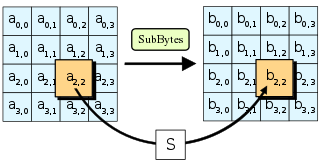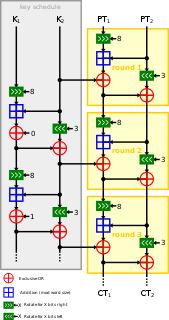Related Research Articles

The Advanced Encryption Standard (AES), also known by its original name Rijndael, is a specification for the encryption of electronic data established by the U.S. National Institute of Standards and Technology (NIST) in 2001.
Blowfish is a symmetric-key block cipher, designed in 1993 by Bruce Schneier and included in many cipher suites and encryption products. Blowfish provides a good encryption rate in software and no effective cryptanalysis of it has been found to date. However, the Advanced Encryption Standard (AES) now receives more attention, and Schneier recommends Twofish for modern applications.
In cryptography, a block cipher is a deterministic algorithm operating on fixed-length groups of bits, called blocks. It uses an unvarying transformation, that is, it uses a symmetric key. They are specified elementary components in the design of many cryptographic protocols and are widely used to implement the encryption of large amounts of data, including data exchange protocols.

Cryptanalysis is the study of analyzing information systems in order to study the hidden aspects of the systems. Cryptanalysis is used to breach cryptographic security systems and gain access to the contents of encrypted messages, even if the cryptographic key is unknown.

The Data Encryption Standard is a symmetric-key algorithm for the encryption of digital data. Although its short key length of 56 bits makes it too insecure for applications, it has been highly influential in the advancement of cryptography.

In cryptography, the International Data Encryption Algorithm (IDEA), originally called Improved Proposed Encryption Standard (IPES), is a symmetric-key block cipher designed by James Massey of ETH Zurich and Xuejia Lai and was first described in 1991. The algorithm was intended as a replacement for the Data Encryption Standard (DES). IDEA is a minor revision of an earlier cipher Proposed Encryption Standard (PES).
Symmetric-key algorithms are algorithms for cryptography that use the same cryptographic keys for both the encryption of plaintext and the decryption of ciphertext. The keys may be identical, or there may be a simple transformation to go between the two keys. The keys, in practice, represent a shared secret between two or more parties that can be used to maintain a private information link. The requirement that both parties have access to the secret key is one of the main drawbacks of symmetric-key encryption, in comparison to public-key encryption.

In cryptography, ciphertext or cyphertext is the result of encryption performed on plaintext using an algorithm, called a cipher. Ciphertext is also known as encrypted or encoded information because it contains a form of the original plaintext that is unreadable by a human or computer without the proper cipher to decrypt it. Thus preventing loss of sensitive information via hacking. Decryption, the inverse of encryption, is the process of turning ciphertext into readable plaintext. Ciphertext is not to be confused with codetext because the latter is a result of a code, not a cipher.
Articles related to cryptography include:

In cryptography, DES-X is a variant on the DES symmetric-key block cipher intended to increase the complexity of a brute-force attack using a technique called key whitening.
In cryptography, Khufu and Khafre are two block ciphers designed by Ralph Merkle in 1989 while working at Xerox's Palo Alto Research Center. Along with Snefru, a cryptographic hash function, the ciphers were named after the Egyptian Pharaohs Khufu, Khafre and Sneferu.
In cryptography, Madryga is a block cipher published in 1984 by W. E. Madryga. It was designed to be easy and efficient for implementation in software. Serious weaknesses have since been found in the algorithm, but it was one of the first encryption algorithms to make use of data-dependent rotations, later used in other ciphers, such as RC5 and RC6.
Multiple encryption is the process of encrypting an already encrypted message one or more times, either using the same or a different algorithm. It is also known as cascade encryption, cascade ciphering, multiple encryption, and superencipherment. Superencryption refers to the outer-level encryption of a multiple encryption.
In cryptography, REDOC II and REDOC III are block ciphers designed by Michael Wood (cryptographer) for Cryptech Inc and are optimised for use in software. Both REDOC ciphers are patented.
In cryptography, SXAL is a block cipher designed in 1993 by Yokohama-based Laurel Intelligent Systems. It is normally used in a special mode of operation called MBAL . SXAL/MBAL has been used for encryption in a number of Japanese PC cards and smart cards.
In cryptography, M8 is a block cipher designed by Hitachi in 1999. The algorithm negotiates introduced in 1997 M6, with the modified key length, which is enlarged to 64 bits or more. This cipher operates with Feistel network and designed to reach high performance on small implementation or 32 bits devices. For instance, by using round numbers = 10 it present encryption speed at 32 Mbps for dedicated hardware of 6K gates and 25 MHz clock or 208 Mbps for program, that uses C-language and Pentium-I 266 MHz. Due to the openness of description, it should not be used in open or multivendor software.
ORYX is an encryption algorithm used in cellular communications in order to protect data traffic. It is a stream cipher designed to have a very strong 96-bit key strength with a way to reduce the strength to 32-bits for export. However, due to mistakes the actual strength is a trivial 16-bits and any signal can be cracked after the first 25–27 bytes.

Cryptography, or cryptology, is the practice and study of techniques for secure communication in the presence of third parties called adversaries. More generally, cryptography is about constructing and analyzing protocols that prevent third parties or the public from reading private messages; various aspects in information security such as data confidentiality, data integrity, authentication, and non-repudiation are central to modern cryptography. Modern cryptography exists at the intersection of the disciplines of mathematics, computer science, electrical engineering, communication science, and physics. Applications of cryptography include electronic commerce, chip-based payment cards, digital currencies, computer passwords, and military communications.
The following outline is provided as an overview of and topical guide to cryptography:

Speck is a family of lightweight block ciphers publicly released by the National Security Agency (NSA) in June 2013. Speck has been optimized for performance in software implementations, while its sister algorithm, Simon, has been optimized for hardware implementations. Speck is an add–rotate–xor (ARX) cipher.
References
- ↑ David Wagner, Bruce Schneier, John Kelsey (August 1997). Cryptanalysis of the Cellular Message Encryption Algorithm (PDF/PostScript). Advances in Cryptology - CRYPTO '97, 17th Annual International Cryptology Conference. Santa Barbara, California. pp. 526–537. Retrieved 2007-02-07.CS1 maint: multiple names: authors list (link)
- ↑ Thomas Chardin; Raphaël Marinier. "Cryptanalysis of the Improved Cellular Message Encryption Algorithm" (PDF).